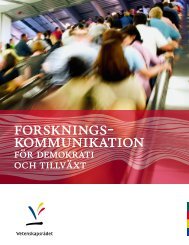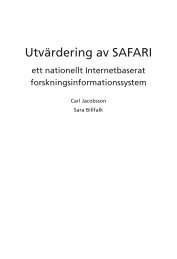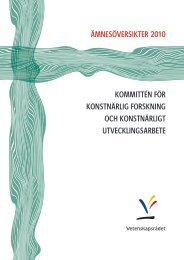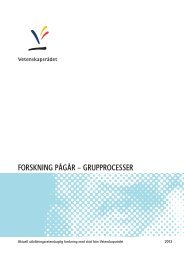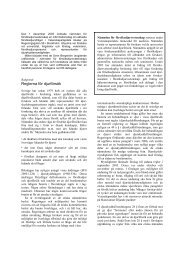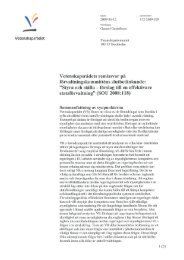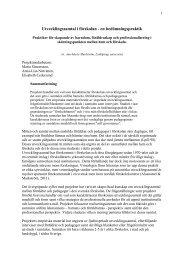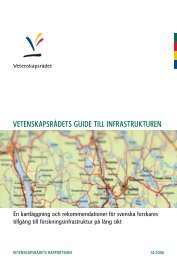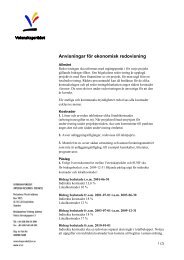vetenskapsrådets kartläggning, utvärdering och rekommendationer ...
vetenskapsrådets kartläggning, utvärdering och rekommendationer ...
vetenskapsrådets kartläggning, utvärdering och rekommendationer ...
You also want an ePaper? Increase the reach of your titles
YUMPU automatically turns print PDFs into web optimized ePapers that Google loves.
2 KARTLÄGGNING OCH UTVÄRDERING AV SVENSK VÅRDFORSKNING – HUVUDRAPPORT OCH UNDERLAG FÖR VETENSKAPSRÅDETS REKOMMENDATIONER<br />
ded. A nationally agreed template for completion may be one approach<br />
to ensure consistency. The panel also realised that the self-evaluation was<br />
a challenge to those large institutions where there were large numbers<br />
of research projects and a variety of topics. In contrast, some small university<br />
colleges were able to produce a more coherent report due to their<br />
more modest research activities and smaller cohort of researchers.<br />
Staffing Issues<br />
• Many of the senior staff are over sixty years of age and in many instances<br />
there were more staff over fifty years of age than there were below fifty.<br />
While this may be understandable due to the desire among care science staff<br />
to gain some years of clinical experience and/or raise a family, it does raise<br />
issues of sustainability and succession planning. The panel suggests that this<br />
should be addressed through support for early career researchers, research<br />
masters courses, short courses on research skills, clinical-academic career<br />
pathways and joint appointments between academic and clinical practice.<br />
• In many universities, there appeared to be a gender imbalance. While the<br />
panel recognised that most of the caring science academic staff are female,<br />
there was a disproportionate number of male professors.<br />
• The panel detected that some research staff had heavy administration<br />
and teaching loads. While this is understandable in this field, there should<br />
be some ’protected time’ for active researchers to get relief from nonresearch<br />
activities.<br />
Research Collaborations and Partnerships<br />
• The panel were impressed with many of the ongoing research collaborations<br />
and networks but most of these tended to be at regional and/or national<br />
level. There was less evidence of meaningful and focused collaborations<br />
internationally. Where this was the case, it was not always possible to see<br />
the results of these collaborations in the form of joint publications, grant<br />
applications and conference presentations. Some universities had strong<br />
collaborations and partnerships with their local health services, councils,<br />
municipalities, charities, business and service user organisations. Such collaborations<br />
were perceived positively by the panel but were not common.<br />
• It was disappointing for the panel to note that while several different<br />
universities across Sweden were undertaking research in identical areas,<br />
there was no obvious collaboration or sharing of ideas, methodologies<br />
or research instruments. To address this, there should be collaboration<br />
among centres on specific topics. One way of approaching this is through<br />
the establishment of network ’hubs’ in centres of excellence with ’spokes’<br />
linking such centres to research groups in other institutions that are un-<br />
VETENSKAPSRÅDETS KARTLÄGGNING, UTVÄRDERING OCH REKOMMENDATIONER ANGÅENDE SVENSK VÅRDFORSKNING 25





